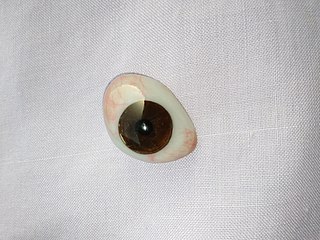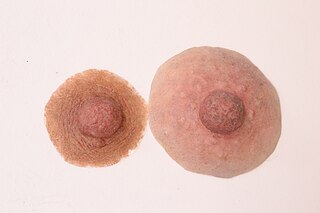
In medicine, a prosthesis or prosthetic implant is an artificial device that replaces a missing body part, which may be lost through trauma, disease, or a condition present at birth. Prostheses are intended to restore the normal functions of the missing body part. Amputee rehabilitation is primarily coordinated by a physiatrist as part of an inter-disciplinary team consisting of physiatrists, prosthetists, nurses, physical therapists, and occupational therapists. Prostheses can be created by hand or with computer-aided design (CAD), a software interface that helps creators design and analyze the creation with computer-generated 2-D and 3-D graphics as well as analysis and optimization tools.

A dental technologist is a member of the dental team who, upon prescription from a dental clinician, constructs custom-made restorative and dental appliances.
A facial prosthetic or facial prosthesis is an artificial device used to change or adapt the outward appearance of a person's face or head.
Neuroprosthetics is a discipline related to neuroscience and biomedical engineering concerned with developing neural prostheses. They are sometimes contrasted with a brain–computer interface, which connects the brain to a computer rather than a device meant to replace missing biological functionality.
An ocularist is someone who specializes in the fabrication and fitting of ocular prostheses for people who have lost an eye or eyes due to trauma or illness. The fabrication process for a custom made eye typically includes taking an impression of the eye socket, shaping a plastic shell, painting the iris and then fitting the ocular prostheses. Prefabricated ocular prostheses with different colored iris are also available. Ocularist may select the stock eye which is closely matched to patient iris color. Due to better adaptation, comfort and esthetics custom-made ocular prosthesis is more accepted. In addition to creating the prosthetic eye, they show the patient how to care for and handle the prosthesis.

A palatal lift prosthesis is a prosthesis that addresses a condition referred to as palatopharyngeal incompetence. Palatopharyngeal incompetence broadly refers to a muscular inability to sufficiently close the port between the nasopharynx and oropharynx during speech and/or swallowing. An inability to adequately close the palatopharyngeal port during speech results in hypernasalance that, depending upon its severity, can render speakers difficult to understand or unintelligible. The potential for compromised intelligibility secondary to hypernasalance is underscored when consideration is given to the fact that only three English language phonemes – /m/, /n/, and /ng/ – are pronounced with an open palatopharyngeal port. Furthermore, an impaired ability to effect a closure of the palatopharyngeal port while swallowing can result in the nasopharyngeal regurgitation of liquid or solid boluses.

Breast prostheses are breast forms intended to look like breasts. They are often used temporarily or permanently by women after mastectomy or lumpectomy procedures, but may also be used by for aesthetic purposes. There are a number of materials and designs; although, the most common construction is gel in a plastic film meant to feel similar to a person's skin. Prostheses may be purchased at a surgical supply store, pharmacy, custom lingerie shop, or even through private services that come to a person's home. There are many types of ready made breast prostheses including full or standard prostheses, partial prostheses such a shell prostheses, and stick on prostheses. Customized options are also available from specialty shops, which are moulded to fit an individual's chest by taking an impression of the breast(s). The areola and nipple may be replicated as part of the breast form or as separate nipple prosthesis. Both custom made and off-the shelf breast prostheses come in varieties that are designed to either be held in a pocket in a specially designed mastectomy bra or attached to the skin via adhesive or other methods and worn with a standard bra. There are many factors to consider when selecting breast prostheses such as different types and the care they require, insurance coverage, and psychosocial effects.

Craniofacial prostheses are prostheses made by individuals trained in anaplastology or maxillofacial prosthodontics who medically help rehabilitate those with facial defects caused by disease, trauma or birth defects. They have the ability to replace almost any part of the face, but most commonly the ear, nose or eye/eyelids. An ocular prosthesis and hair prosthesis can also be classified as craniofacial prostheses. Prostheses are held in place either by biocompatible drying adhesives, osseointegrated implants, magnets, or another mechanical means such as glasses or straps. Prostheses are designed to be as similar as possible to the natural anatomy of each individual. Their purpose is to cover, protect, and disguise facial disfigurements or underdevelopments.

An ocular prosthesis, artificial eye or glass eye is a type of craniofacial prosthesis that replaces an absent natural eye following an enucleation, evisceration, or orbital exenteration. The prosthesis fits over an orbital implant and under the eyelids. Though often referred to as a glass eye, the ocular prosthesis roughly takes the shape of a convex shell and is made of medical grade plastic acrylic. A few ocular prostheses today are made of cryolite glass. A variant of the ocular prosthesis is a very thin hard shell known as a scleral shell which can be worn over a damaged or eviscerated eye. Makers of ocular prosthetics are known as ocularists. An ocular prosthesis does not provide vision; this would be a visual prosthesis. Someone with an ocular prosthesis is altogether blind on the affected side and has monocular vision.

A penile implant is an implanted device intended for the treatment of erectile dysfunction, Peyronie's disease, ischemic priapism, deformity and traumatic injury of the penis, and for phalloplasty in men or phalloplasty and metoidioplasty in female-to-male gender reassignment surgery. Although there are many distinct types of implants, most fall into one of two categories: malleable and inflatable.
James Foort was a Canadian inventor, artist, and innovator in the field of prosthetic limbs.
Targeted reinnervation enables amputees to control motorized prosthetic devices and to regain sensory feedback. The method was developed by Dr. Todd Kuiken at Northwestern University and Rehabilitation Institute of Chicago and Dr. Gregory Dumanian at Northwestern University Division of Plastic Surgery.

Nose prosthesis is a craniofacial prosthesis for someone who no longer has their original nose. Nose prostheses are designed by anaplastologists who have their patients referred to them by ear, nose, and throat doctors and plastic surgeons. Unlike the more common nasal operation called a rhinoplasty, total reconstruction of the nose using existing tissue, prosthetic nose implantation requires the nose to be made completely from synthetic material; prior to getting a nose prosthesis, the original nose is usually left partially intact, so a rhinectomy, surgical removal of the nose, has to be performed before a prosthetic nose can be used. One of the biggest challenges for anaplastologists in constructing a nose prosthesis is finding the right material to use for the nose, as it's a complex organ with several distinct functions and a unique structure. The major functions of the nose include the sense of smell (olfaction), filtered breathing, and alteration of speech. All of these tasks can be completed due to the nose’s network of bones, cartilage, and muscle, which also helps to keep the nose stable on the face. Although there are currently usable prosthetic noses, they only have temporary functionality. Advancements in areas such as 3D-printing have medical professionals hoping to create noses that are as efficient as the real ones.
Computer-assisted surgery (CAS) represents a surgical concept and set of methods, that use computer technology for surgical planning, and for guiding or performing surgical interventions. CAS is also known as computer-aided surgery, computer-assisted intervention, image-guided surgery and surgical navigation, but these are terms that are more or less synonymous with CAS. CAS has been a leading factor in the development of robotic surgery.
A hippocampus prosthesis is a type of cognitive prosthesis. Prosthetic devices replace normal function of a damaged body part; this can be simply a structural replacement or a rudimentary, functional replacement. However, prosthetics involving the brain have some special categories and requirements. "Input" prosthetics, such as retinal or cochlear implant, supply signals to the brain that the patient eventually learns to interpret as sight or sound. "Output" prosthetics use brain signals to drive a bionic arm, hand or computer device, and require considerable training during which the patient learns to generate the desired action via their thoughts. Both of these types of prosthetics rely on the plasticity of the brain to adapt to the requirement of the prosthesis, thus allowing the user to "learn" the use of his new body part. A cognitive or "brain-to-brain" prosthesis involves neither learned input nor output signals, but the native signals used normally by the area of the brain to be replaced. Thus, such a device must be able to fully replace the function of a small section of the nervous system—using that section's normal mode of operation. In order to achieve this, developers require a deep understanding of the functioning of the nervous system. The scope of design must include a reliable mathematical model as well as the technology in order to properly manufacture and install a cognitive prosthesis. The primary goal of an artificial hippocampus is to provide a cure for Alzheimer's disease and other hippocampus—related problems. To do so, the prosthesis has to be able to receive information directly from the brain, analyze the information and give an appropriate output to the cerebral cortex; in other words, it must behave just like a natural hippocampus. At the same time, the artificial organ must be completely autonomous, since any exterior power source will greatly increase the risk of infection.

Markus Rehm is a German amputee and Paralympian. He began in sports at age 20 and became a long jump F44 world champion in 2011. His club is TSV Bayer 04 Leverkusen and he is a medical specialist. Rehm is nicknamed "The Blade Jumper", as he is a long jumper with a blade-type leg prosthesis. Rehm's right leg is amputated and he uses a carbon-fibre bladed prosthesis, from which he jumps off.

Nipple/Areola prostheses are made of silicone by breast prosthesis manufacturers and anaplastologists for breast cancer survivors who were treated for breast cancer with a mastectomy. Prostheses can be worn weeks after a mastectomy, breast reconstruction, or even nipple reconstruction. As an inexpensive and convenient alternative to surgery, patients may choose to wear them anytime during treatment. Patients who ultimately find nipple prostheses thought that they should be informed of them during the consultation prior to mastectomy.
Robotic prosthesis control is a method for controlling a prosthesis in such a way that the controlled robotic prosthesis restores a biologically accurate gait to a person with a loss of limb. This is special branch of control that has an emphasis on the interaction between humans and robotics.

Legs4Africa is a British registered charity. It collects used prosthetic legs, which under EU law cannot be re-used in the United Kingdom, and ships them to African countries such as The Gambia, Senegal, Tanzania, where they can be modified for, and used by, amputees and land mine victims.
Dynamic Roentgen stereophotogrammetry is a modern and sophisticated x-ray recording method, used to measure real-time 3D motions of prostheses and bones during motion with high accuracy. It is mostly used in orthopedic research settings and is an advancement of conventional RSA.










